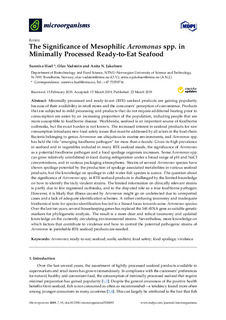| dc.contributor.author | Hoel, Sunniva | |
| dc.contributor.author | Vadstein, Olav | |
| dc.contributor.author | Jakobsen, Anita Nordeng | |
| dc.date.accessioned | 2019-04-10T05:47:11Z | |
| dc.date.available | 2019-04-10T05:47:11Z | |
| dc.date.created | 2019-03-26T15:15:41Z | |
| dc.date.issued | 2019 | |
| dc.identifier.citation | Microorganisms. 2019, 7 (91), . | nb_NO |
| dc.identifier.issn | 2076-2607 | |
| dc.identifier.uri | http://hdl.handle.net/11250/2593909 | |
| dc.description.abstract | Minimally processed and ready-to-eat (RTE) seafood products are gaining popularity because of their availability in retail stores and the consumers’ perception of convenience. Products that are subjected to mild processing and products that do not require additional heating prior to consumption are eaten by an increasing proportion of the population, including people that are more susceptible to foodborne disease. Worldwide, seafood is an important source of foodborne outbreaks, but the exact burden is not known. The increased interest in seafood products for raw consumption introduces new food safety issues that must be addressed by all actors in the food chain. Bacteria belonging to genus Aeromonas are ubiquitous in marine environments, and Aeromonas spp. has held the title “emerging foodborne pathogen” for more than a decade. Given its high prevalence in seafood and in vegetables included in many RTE seafood meals, the significance of Aeromonas as a potential foodborne pathogen and a food spoilage organism increases. Some Aeromonas spp. can grow relatively uninhibited in food during refrigeration under a broad range of pH and NaCl concentrations, and in various packaging atmospheres. Strains of several Aeromonas species have shown spoilage potential by the production of spoilage associated metabolites in various seafood products, but the knowledge on spoilage in cold water fish species is scarce. The question about the significance of Aeromonas spp. in RTE seafood products is challenged by the limited knowledge on how to identify the truly virulent strains. The limited information on clinically relevant strains is partly due to few registered outbreaks, and to the disputed role as a true foodborne pathogen. However, it is likely that illness caused by Aeromonas might go on undetected due to unreported cases and a lack of adequate identification schemes. A rather confusing taxonomy and inadequate biochemical tests for species identification has led to a biased focus towards some Aeromonas species. Over the last ten years, several housekeeping genes has replaced the 16S rRNA gene as suitable genetic markers for phylogenetic analysis. The result is a more clear and robust taxonomy and updated knowledge on the currently circulating environmental strains. Nevertheless, more knowledge on which factors that contribute to virulence and how to control the potential pathogenic strains of Aeromonas in perishable RTE seafood products are needed. | nb_NO |
| dc.language.iso | eng | nb_NO |
| dc.publisher | MDPI | nb_NO |
| dc.rights | Navngivelse 4.0 Internasjonal | * |
| dc.rights | Navngivelse 4.0 Internasjonal | * |
| dc.rights.uri | http://creativecommons.org/licenses/by/4.0/deed.no | * |
| dc.title | The Significance of Mesophilic Aeromonas spp. in Minimally Processed Ready-to-Eat Seafood | nb_NO |
| dc.type | Journal article | nb_NO |
| dc.type | Peer reviewed | nb_NO |
| dc.description.version | publishedVersion | nb_NO |
| dc.source.pagenumber | 25 | nb_NO |
| dc.source.volume | 7 | nb_NO |
| dc.source.journal | Microorganisms | nb_NO |
| dc.source.issue | 91 | nb_NO |
| dc.identifier.doi | https://doi.org/10.3390/microorganisms7030091 | |
| dc.identifier.cristin | 1687913 | |
| dc.description.localcode | © 2019 by the authors. Licensee MDPI, Basel, Switzerland. This article is an open access article distributed under the terms and conditions of the Creative Commons Attribution (CC BY) license (http://creativecommons.org/licenses/by/4.0/). | nb_NO |
| cristin.unitcode | 194,66,15,0 | |
| cristin.unitname | Institutt for bioteknologi og matvitenskap | |
| cristin.ispublished | true | |
| cristin.fulltext | original | |
| cristin.qualitycode | 1 | |

